Abstract
Volume replacement is the most important step in treating hypovolaemic shock.
Blood is needed when the oxygen carrying capacity threatens to fall below a critical level, but has the disadvantage of transmitting virus hepatitis. Anicteric hepatitis is about four times more frequent than the icteric form. Pasteurized plasma protein solution and albumin are free from the risk of transmitting hepatitis virus, and are good volume restorers.
Dextran 70 represents the best artificial colloid with additional anti-thrombotic properties. Dextran 40 is indicated in special situations to promote flow.
There is no proof that large amounts of Ringer solution are superior for treating hypovolaemic shock in man compared with colloids and electrolytes.
Full text
PDF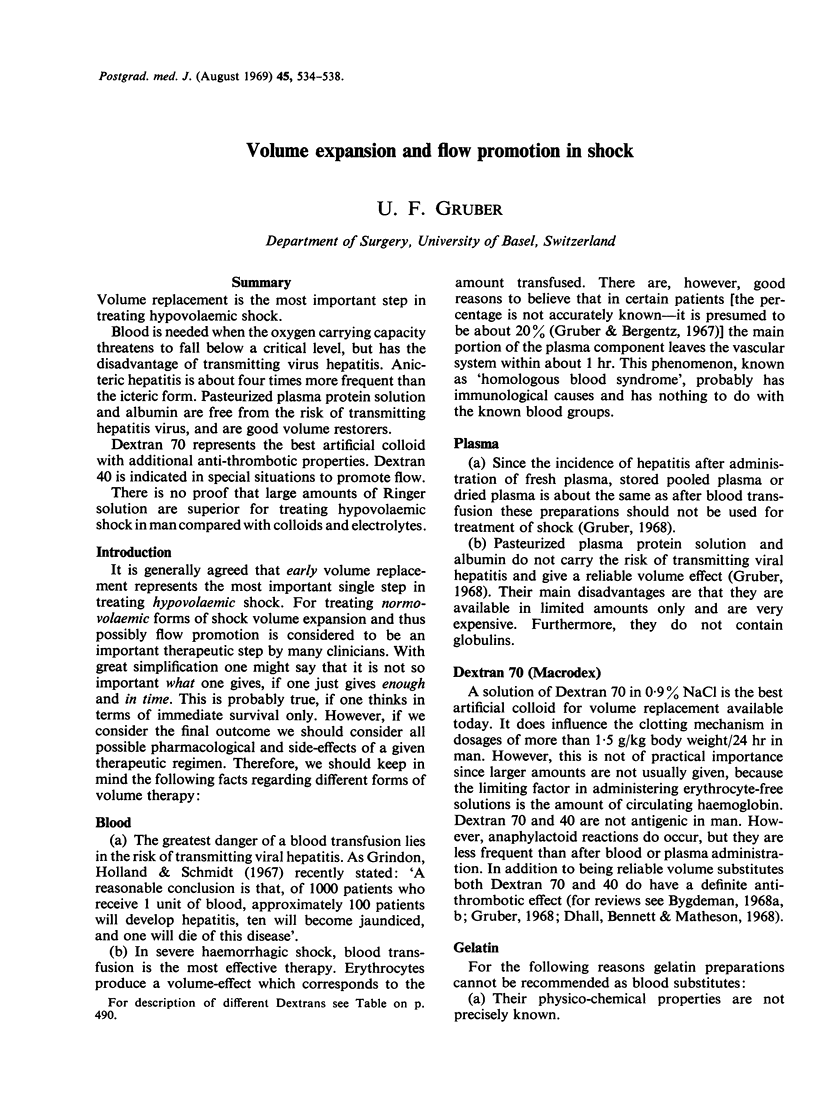
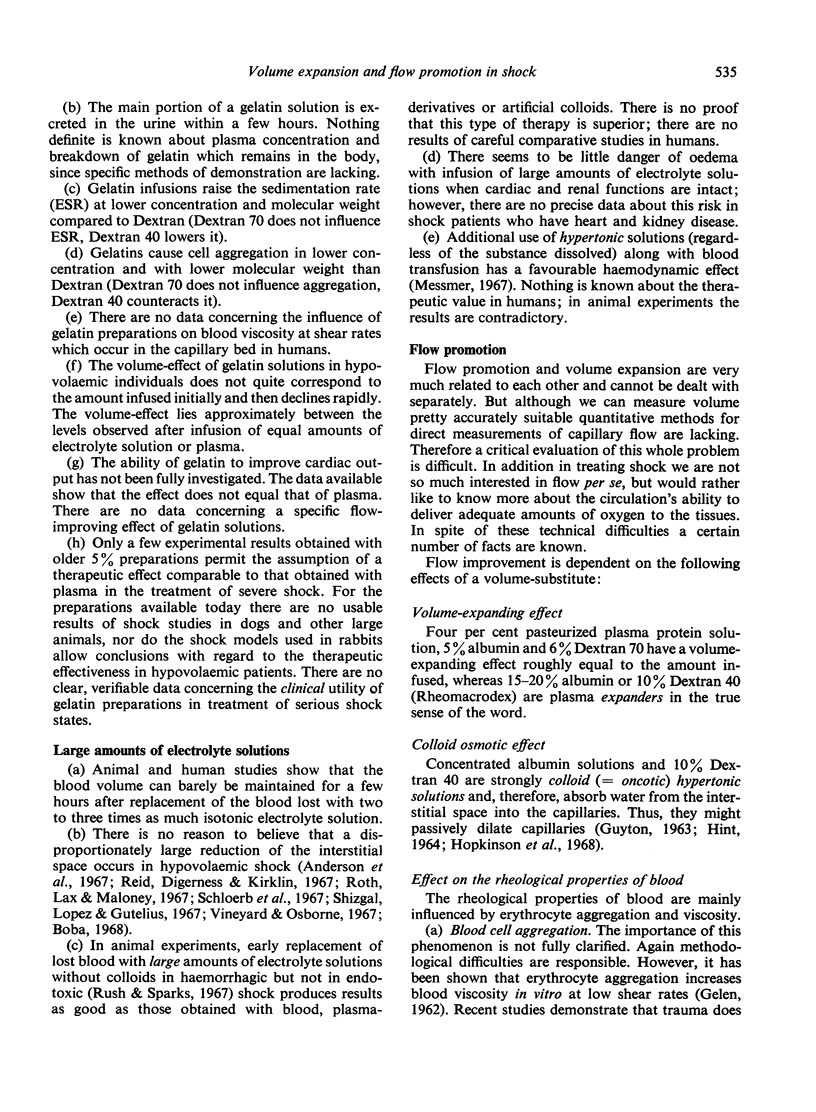
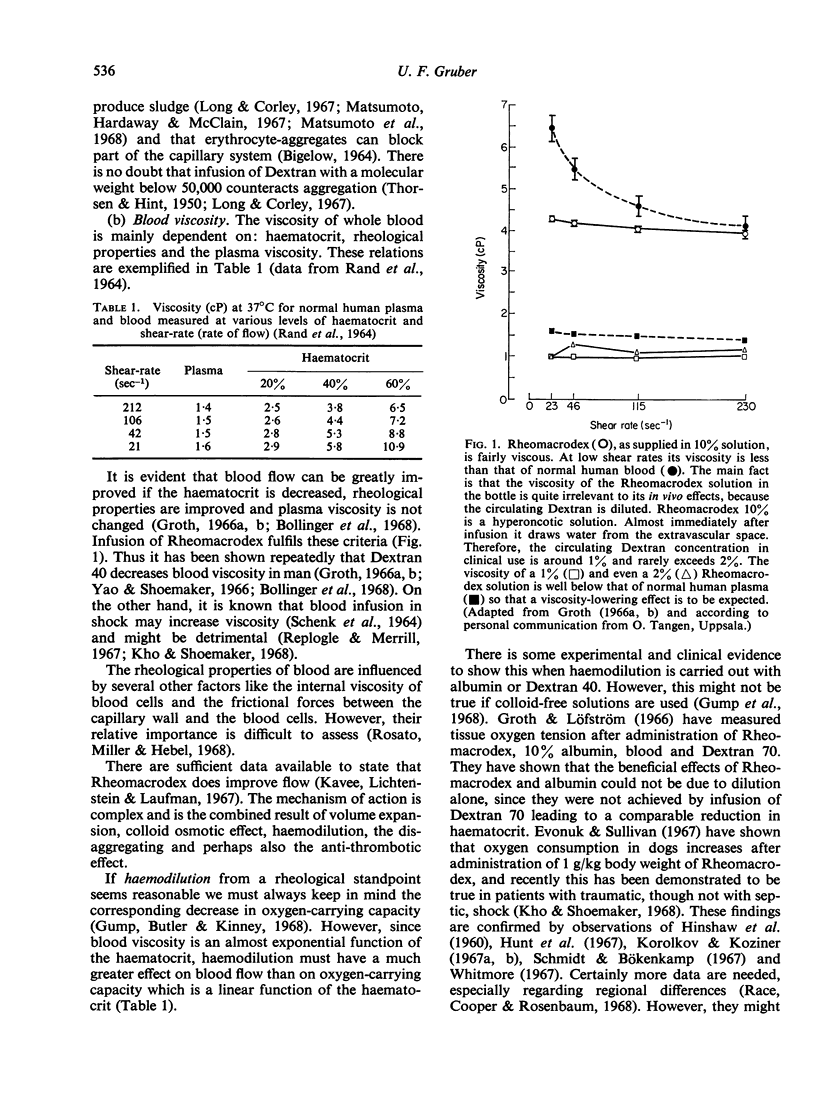
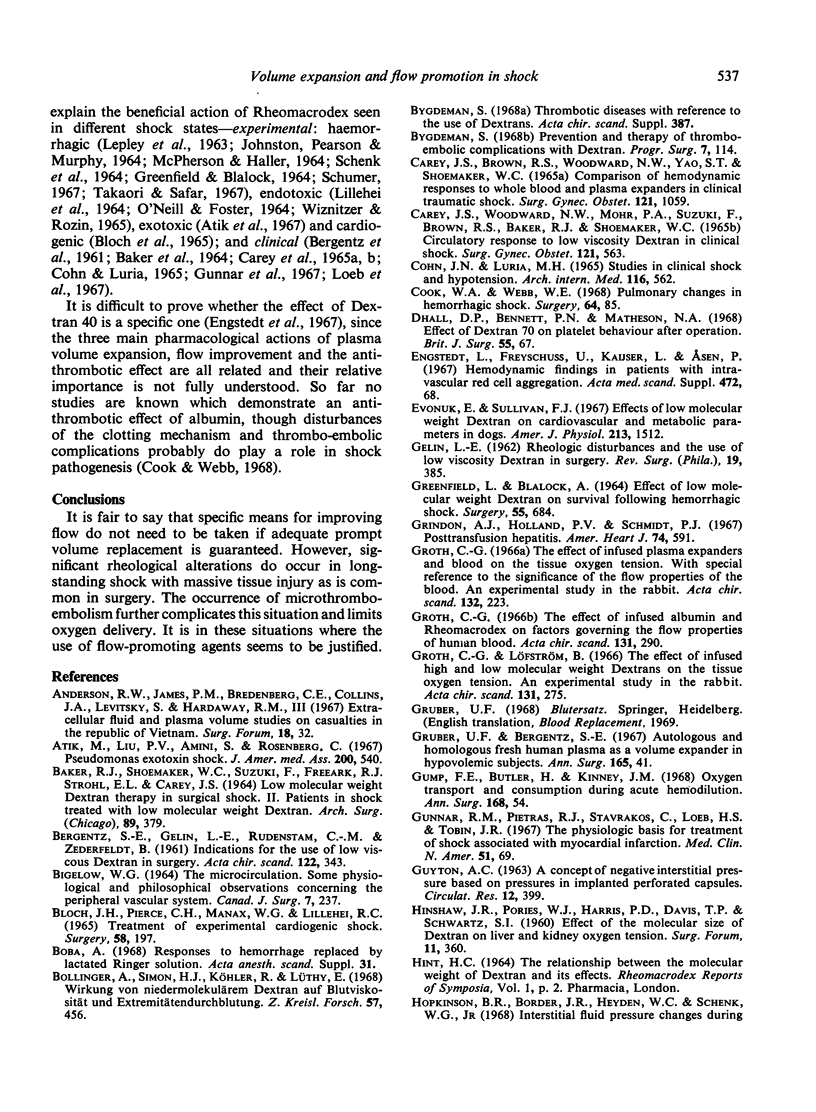
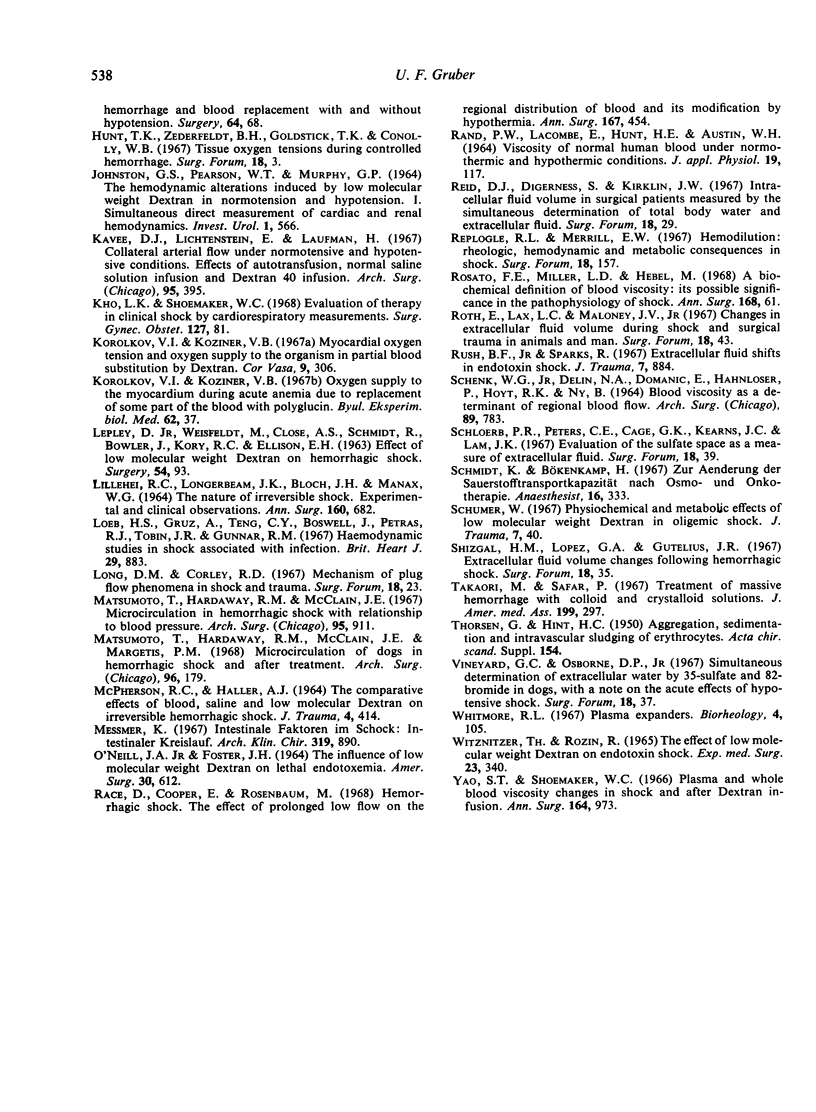
Selected References
These references are in PubMed. This may not be the complete list of references from this article.
- BERGENTZ S. E., GELIN L. E., RUDENSTAM C. M., ZEDERFELDT B. Indications for the use of low viscous dextran in surgery. Acta Chir Scand. 1961 Nov;122:343–357. [PubMed] [Google Scholar]
- BIGELOW W. G. THE MICROCIRCULATION. SOME PHYSIOLOGICAL AND PHILOSOPHICAL OBSERVATIONS CONCERNING THE PERIPHERAL VASCULAR SYSTEM. Can J Surg. 1964 Jul;7:237–250. [PubMed] [Google Scholar]
- BLOCH J. H., PIERCE C. H., MANAX W. G., LILLEHEI R. C. TREATMENT OF EXPERIMENTAL CARDIOGENIC SHOCK. Surgery. 1965 Jul;58:197–214. [PubMed] [Google Scholar]
- Bollinger A., Simon H. J., Köhler R., Lüthy E. Wirkung von neidermolekulärem Dextran auf Blutviskosität und Extremitätendurchblutung. Z Kreislaufforsch. 1968 May;57(5):456–465. [PubMed] [Google Scholar]
- Bygdeman S. Prevention and therapy of thromboembolic complications with dextran. Prog Surg. 1969;7:114–139. doi: 10.1159/000386300. [DOI] [PubMed] [Google Scholar]
- CAREY J. S., WOODWARD N. W., MOHR P. A., SUZUKI F., BROWN R. S., BAKER R. J., SHOEMAKER W. C. CIRCULATORY RESPONSE TO LOW VISCOSITY DEXTRAN IN CLINICAL SHOCK. Surg Gynecol Obstet. 1965 Sep;121:563–570. [PubMed] [Google Scholar]
- Carey J. S., Brown R. S., Woodward N. W., Yao S. T., Shoemaker W. C. Comparison of hemodynamic responses to whole blood and plasma expanders in clinical traumatic shock. Surg Gynecol Obstet. 1965 Nov;121(5):1059–1065. [PubMed] [Google Scholar]
- Cohn J. N., Luria M. H. Studies in clinical shock and hypotension. 3. Comparative effects of vasopressor drugs and dextran. Arch Intern Med. 1965 Oct;116(4):562–566. [PubMed] [Google Scholar]
- Cook W. A., Webb W. R. Pulmonary changes in hemorrhagic shock. Surgery. 1968 Jul;64(1):85–94. [PubMed] [Google Scholar]
- Engstedt L., Freyschuss U., Kaijser L., Asén P. Hemodynamic findings in patients with intravascular red cell aggregation. Acta Med Scand Suppl. 1967;472:68–74. doi: 10.1111/j.0954-6820.1967.tb12615.x. [DOI] [PubMed] [Google Scholar]
- Evonuk E., Sullivan F. J. Effects of low molecular weight dextran on cardiovascular and metabolic parameters in dogs. Am J Physiol. 1967 Dec;213(6):1512–1514. doi: 10.1152/ajplegacy.1967.213.6.1512. [DOI] [PubMed] [Google Scholar]
- GELIN L. E. Rheologic disturbances and the use of low viscosity dextran in surgery. Rev Surg. 1962 Nov-Dec;19:385–400. [PubMed] [Google Scholar]
- GREENFIELD L., BLALOCK A. EFFECT OF LOW MOLECULAR WEIGHT DEXTRAN ON SURVIVAL FOLLOWING HEMORRHAGIC SHOCK. Surgery. 1964 May;55:684–686. [PubMed] [Google Scholar]
- GUYTON A. C. A concept of negative interstitial pressure based on pressures in implanted perforated capsules. Circ Res. 1963 Apr;12:399–414. doi: 10.1161/01.res.12.4.399. [DOI] [PubMed] [Google Scholar]
- Grindon A. J., Holland P. V., Schmidt P. J. Posttransfusion hepatitis. Am Heart J. 1967 Nov;74(5):591–594. doi: 10.1016/0002-8703(67)90498-x. [DOI] [PubMed] [Google Scholar]
- Groth C. G., Löfström B. The effect of infused high and low molecular weight dextrans on the tissue oxygen tension. An experimental study on the rabbit. Acta Chir Scand. 1966 Apr;131(4):275–289. [PubMed] [Google Scholar]
- Groth C. G. The effect of infused albumin and Rheomacrodex on factors governing the flow properties of the human blood. Acta Chir Scand. 1966 Apr;131(4):290–297. [PubMed] [Google Scholar]
- Gruber U. F., Bergentz S. E. Autologous and homologous fresh human plasma as a volume expander in hypovolemic subjects. Ann Surg. 1967 Jan;165(1):41–48. doi: 10.1097/00000658-196701000-00005. [DOI] [PMC free article] [PubMed] [Google Scholar]
- Gump F. E., Butler H., Kinney J. M. Oxygen transport and consumption during acute hemodilution. Ann Surg. 1968 Jul;168(1):54–60. doi: 10.1097/00000658-196807000-00006. [DOI] [PMC free article] [PubMed] [Google Scholar]
- Gunnar R. M., Pietras R. J., Stavrakos C., Loeb H. S., Tobin J. R., Jr The physiologic basis for treatment of shock associated with myocardial infarction. Med Clin North Am. 1967 Jan;51(1):69–81. doi: 10.1016/s0025-7125(16)33083-8. [DOI] [PubMed] [Google Scholar]
- HINSHAW J. R., PORIES W. J., HARRIS P. D., DAVIS T. P., SCHWARTZ S. I. Effect of the molecular size of dextran on liver and kidney oxygen tension. Surg Forum. 1960;11:360–360. [PubMed] [Google Scholar]
- Hopkinson B. R., Border J. R., Heyden W. C., Schenk W. G., Jr Interstitial fluid pressure changes during hemorrhage and blood replacement with and without hypotension. Surgery. 1968 Jul;64(1):68–74. [PubMed] [Google Scholar]
- Hunt T. K., Zederfeldt B. H., Goldstick T. K., Conolly W. B. Tissue oxygen tensions during controlled hemorrhage. Surg Forum. 1967;18:3–4. [PubMed] [Google Scholar]
- JOHNSTON G. S., PEARSON W. T., MURPHY G. P. THE HEMODYNAMIC ALTERATIONS INDUCED BY LOW MOLECULAR WEIGHT DEXTRAN IN NORMOTENSION AND HYPOTENSION. I. SIMULTANEOUS DIRECT MEASUREMENT OF CARDIAC AND RENAL HEMODYNAMICS. Invest Urol. 1964 May;1:566–573. [PubMed] [Google Scholar]
- Kavee D. J., Lichtenstein E., Laufman H. Collateral arterial flow under normotensive and hypotensive conditions. Effects of autotransfusion, normal saline solution infusion, and dextran 40 infusion. Arch Surg. 1967 Sep;95(3):395–401. doi: 10.1001/archsurg.1967.01330150071011. [DOI] [PubMed] [Google Scholar]
- Kho L. K., Shoemaker W. C. Evaluation of therapy in clinical shock by cardiorespiratory measurements. Surg Gynecol Obstet. 1968 Jul;127(1):81–88. [PubMed] [Google Scholar]
- Korol'kov V. I., Koziner V. B. Kislorodnoe snabzhenie miokarda v usloviiakh ostroi anemii, vyzvannoi zameshcheniem chasti krovi poligliukinom. Biull Eksp Biol Med. 1966 Sep;62(9):37–41. [PubMed] [Google Scholar]
- Korol'kov V. I., Koziner V. B. Myocardial oxygen tension and oxygen supply to the organism in partial blood substitution by dextran. Cor Vasa. 1967;9(4):306–314. [PubMed] [Google Scholar]
- LEPLEY D., Jr, WEISFELDT M., CLOSE A. S., SCHMIDT R., BOWLER J., KORY R. C., ELLISON E. H. Effect of low molecular weight dextran on hemorrhagic shock. Surgery. 1963 Jul;54:93–103. [PubMed] [Google Scholar]
- LILLEHEI R. C., LONGERBEAM J. K., BLOCH J. H., MANAX W. G. THE NATURE OF IRREVERSIBLE SHOCK: EXPERIMENTAL AND CLINICAL OBSERVATIONS. Ann Surg. 1964 Oct;160:682–710. doi: 10.1097/00000658-196410000-00012. [DOI] [PMC free article] [PubMed] [Google Scholar]
- Loeb H. S., Cruz A., Teng C. Y., Boswell J., Pietras R. J., Tobin J. R., Jr, Gunnar R. M. Haemodynamic studies in shock associated with infection. Br Heart J. 1967 Nov;29(6):883–894. doi: 10.1136/hrt.29.6.883. [DOI] [PMC free article] [PubMed] [Google Scholar]
- Matsumoto T., Hardaway R. M., 3rd, McClain J. E., Margetis P. M. Microcirculation of dogs in hemorrhagic shock and after treatment. Arch Surg. 1968 Feb;96(2):179–183. doi: 10.1001/archsurg.1968.01330200017003. [DOI] [PubMed] [Google Scholar]
- Matsumoto T., Hardaway R. M., 3rd, McClain J. E. Microcirculation in hemorrhagic shock with relationship to blood pressure. Arch Surg. 1967 Dec;95(6):911–917. doi: 10.1001/archsurg.1967.01330180059011. [DOI] [PubMed] [Google Scholar]
- Messmer K. 163. Intestinale Faktoren im Schock: Intestinaler Kreislauf. Langenbecks Arch Chir. 1967;319:890–909. doi: 10.1007/BF02659411. [DOI] [PubMed] [Google Scholar]
- O'NEILL J. A., Jr, FOSTER J. H. THE INFLUENCE OF LOW MOLECULAR WEIGHT DEXTRAN ON LETHAL ENDOTOXEMIA. Am Surg. 1964 Sep;30:612–616. [PubMed] [Google Scholar]
- RAND P. W., LACOMBE E., HUNT H. E., AUSTIN W. H. VISCOSITY OF NORMAL HUMAN BLOOD UNDER NORMOTHERMIC AND HYPOTHERMIC CONDITIONS. J Appl Physiol. 1964 Jan;19:117–122. doi: 10.1152/jappl.1964.19.1.117. [DOI] [PubMed] [Google Scholar]
- Race D., Cooper E., Rosenbaum M. Hemorrhagic shock: the effect of prolonged low flow on the regional distribution of blood and its modification by hypothermia. Ann Surg. 1968 Apr;167(4):454–466. doi: 10.1097/00000658-196804000-00002. [DOI] [PMC free article] [PubMed] [Google Scholar]
- Rosato F. E., Miller L. D., Hebel M. A biochemical definition of blood viscosity: its possible significance in the pathophysiology of shock. Ann Surg. 1968 Jul;168(1):61–66. doi: 10.1097/00000658-196807000-00007. [DOI] [PMC free article] [PubMed] [Google Scholar]
- Rush B. F., Jr, Sparks R. Extracellular fluid shifts in endotoxin shock. J Trauma. 1967 Nov;7(6):884–888. doi: 10.1097/00005373-196711000-00011. [DOI] [PubMed] [Google Scholar]
- SCHENK W. G., Jr, DELIN N. A., DOMANIG E., HAHNLOSER P., HOYT R. K. BLOOD VISCOSITY AS A DETERMINANT OF REGIONAL BLOOD FLOW. Arch Surg. 1964 Nov;89:783–796. doi: 10.1001/archsurg.1964.01320050029002. [DOI] [PubMed] [Google Scholar]
- Schmidt K., Bökenkamp H. Zur Anderung der Sauerstofftransportkapazität nach Osmo- und Onkotherapie. Anaesthesist. 1967 Nov;16(11):333–337. [PubMed] [Google Scholar]
- Schumer W. Physiochemical and metabolic effects of low molecular weight dextran in oligemic shock. J Trauma. 1967 Jan;7(1):40–47. doi: 10.1097/00005373-196701000-00004. [DOI] [PubMed] [Google Scholar]
- Takaori M., Safar P. Treatment of massive hemorrhage with colloid and crystalloid solutions. Studies in dogs. JAMA. 1967 Jan 30;199(5):297–302. [PubMed] [Google Scholar]
- Wiznitzer T., Rozin R. The effect of low molecular weight dextran on endotoxin shock. Exp Med Surg. 1965;23(4):340–344. [PubMed] [Google Scholar]
- Yao S. T., Shoemaker W. C. Plasma and whole blood viscosity changes in shock and after dextran infusion. Ann Surg. 1966 Dec;164(6):973–984. doi: 10.1097/00000658-196612000-00006. [DOI] [PMC free article] [PubMed] [Google Scholar]


